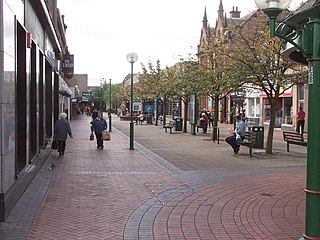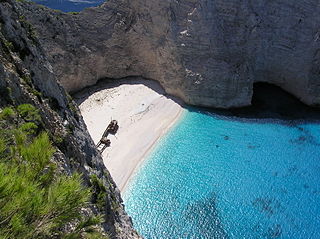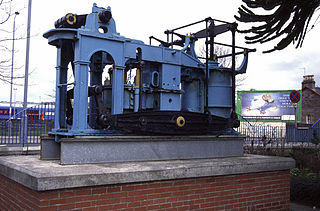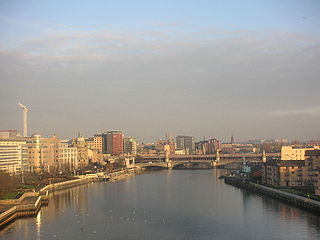
The Forth and Clyde Canal is a canal opened in 1790, crossing central Scotland; it provided a route for the seagoing vessels of the day between the Firth of Forth and the Firth of Clyde at the narrowest part of the Scottish Lowlands. It is 35 miles (56 km) long and it runs from the River Carron at Grangemouth to the River Clyde at Bowling, and had an important basin at Port Dundas in Glasgow.

A steamboat is a boat that is propelled primarily by steam power, typically driving propellers or paddlewheels. Steamboats sometimes use the prefix designation SS, S.S. or S/S or PS, however these designations are most often used for steamships.

Grangemouth is a town in the Falkirk council area, Scotland. Historically part of the county of Stirlingshire, the town lies in the Forth Valley, on the banks of the Firth of Forth, 3 miles (4.8 km) east of Falkirk, 5 miles (8.0 km) west of Bo'ness and 13 miles (20.9 km) south-east of Stirling. Grangemouth had a resident population of 17,906 according to the 2001 Census. Preliminary figures from the 2011 census reported the number as 17,373.

RFA Lyme Bay is a Bay-class auxiliary landing ship dock of the British Royal Fleet Auxiliary (RFA). Ordered from Swan Hunter in 2000, the ship was launched in 2005. However, cost overruns and delays saw the shipbuilder removed from the project, and the incomplete ship was towed to Govan for finishing by BAE Systems Naval Ships. Lyme Bay entered service in late 2007; the last ship of the class to join the RFA.

The River class is a class of offshore patrol vessels built primarily for the Royal Navy of the United Kingdom. A total of nine are planned for the Royal Navy; four Batch 1 and five Batch 2. The Batch 1 ships of the class replaced the seven ships of the Island class and the two Castle-class patrol vessels. HTMS Krabi is a variation of the River design built in Thailand for the Royal Thai Navy. The three ships of the Amazonas-class corvette in service with the Brazilian Navy are also a variation of the River design.

Falls of Clyde is the last surviving iron-hulled, four-masted full-rigged ship, and the only remaining sail-driven oil tanker. Designated a U.S. National Historic Landmark in 1989, she is now a museum ship in Honolulu, but her condition has deteriorated. She is currently not open to the public. In September 2008, ownership was transferred to a new nonprofit organization, the Friends of Falls of Clyde, which intends to restore her. Efforts to raise $1.5 million to get the ship into drydock have not succeeded as of 2015. An additional $30 million may be needed to fully restore the ship. On February 7th 2019 the Hawaii Department of Transportation issued a notice of auction and the ship is being sold as is.

TS Queen Mary is a retired Clyde steamer launched in 1933 and now being preserved as a museum ship. She was built at the William Denny shipyard at Dumbarton for Williamson-Buchanan Steamers. The 871 gross registered ton steamer was powered by three direct drive steam turbines, and carried 2,086 passengers making her the largest excursion turbine on the River Clyde.

Yarrow Shipbuilders Limited (YSL), often styled as simply Yarrows, was a major shipbuilding firm based in the Scotstoun district of Glasgow on the River Clyde. It is now part of BAE Systems Surface Ships, owned by BAE Systems, which has also operated the nearby Govan shipyard since 1999.

The Fairfield Shipbuilding and Engineering Company, Limited was a Scottish shipbuilding company in the Govan area on the Clyde in Glasgow. Fairfields, as it is often known, was a major warship builder, turning out many vessels for the Royal Navy and other navies through the First World War and the Second World War. It also built many transatlantic liners, including record breaking ships for the Cunard Line and Canadian Pacific, such as the Blue Riband-winning sisters RMS Campania and RMS Lucania. At the other end of the scale Fairfields built fast cross-channel mail steamers and ferries for locations around the world. These included ships for the Bosporus crossing in Istanbul and some of the early ships used by Thomas Cook for developing tourism on the River Nile.

HMS Clyde is an offshore patrol vessel and is the tenth ship in the Royal Navy to bear the name. She was launched on 14 June 2006 in Portsmouth Naval Base by VT Group shipbuilders in Portsmouth, England, and is the fourth vessel of the River class, with a displacement of 2,000 tonnes and a 30 mm Oerlikon KCB gun in place of the 20 mm gun fitted to Tyne River-class ships. Clyde is slated for decommissioning in 2019, at which time it will be sold to the Brazilian Navy.

John Brown and Company of Clydebank was a Scottish marine engineering and shipbuilding firm. It built many notable and world-famous ships including RMS Lusitania, HMS Hood, HMS Repulse, RMS Queen Mary, RMS Queen Elizabeth and the Queen Elizabeth 2. At its height, from 1900 to the 1950s, it was one of the most highly regarded, and internationally famous, shipbuilding companies in the world. However thereafter, along with other UK shipbuilders, John Brown's found it increasingly difficult to compete with the emerging shipyards in Eastern Europe and the far East. In 1968 John Brown's merged with other Clydeside shipyards to form the Upper Clyde Shipbuilders consortium, but that collapsed in 1971.

William Denny and Brothers Limited, and often referred to simply as Denny, was a Scottish shipbuilding company.
Alexander Stephen and Sons Limited, often referred to simply as Alex Stephens or just Stephens, was a Scottish shipbuilding company based in Linthouse, Glasgow, on the River Clyde.

A & J Inglis, Ltd, was a shipbuilding firm founded by Anthony Inglis and his brother John, engineers and shipbuilders in Glasgow, Scotland in 1862. The firm built over 500 ships in a period of just over 100 years. Their Pointhouse Shipyard was at the confluence of the rivers Clyde and Kelvin. They constructed a wide range of ships, including Clyde steamers, paddle steamers and small ocean liners. In wartime, they built small warships, and in the period after World War II, they built a number of whalers.

The Panagiotis is a shipwreck lying in the white sands of an exposed cove on the coast of Zakynthos, which is among the southernmost of the Ionian Islands of Greece. Navagio ("Shipwreck"), the spot where she lies, is a tourist attraction on the north-western side of the island, with thousands of visitors each year.
Scotstoun Marine Ltd was a shipbuilding company in Glasgow, Scotland, on the River Clyde, formed in 1972 to operate the former shipyard of Charles Connell and Company following the collapse of Upper Clyde Shipbuilders into which it had been amalgamated. Scotstoun Marine Ltd operated as a subsidiary of Govan Shipbuilders. The yard constructed 15 ships between 1972 and 1980 when the yard closed after 119 years of shipbuilding in which 535 ships had been built.
HMS Sansovino was an infantry landing ship in service with the Royal Navy during the late stages of the Second World War.
James Lamont & Co was a shipbuilder and ship-repairer on the Clyde.

Messrs Robert Napier and Sons was a famous firm of Clyde shipbuilders and marine engineers at Govan, Glasgow founded by Robert Napier in 1826. It was moved to Govan for more space in 1841. His sons James and John were taken into partnership in 1853.














